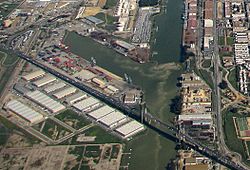Port of Seville facts for kids
Quick facts for kids Port of Seville |
|
|---|---|
 |
|
| Location | |
| Country | Spain |
| Location | Seville |
| Coordinates | 35°17′30″N 2°55′57″W / 35.291791°N 2.932527°W |
| Details | |
| Operated by | Port Authority of Seville |
The Port of Seville is a special kind of port in Spain. It's located on the Guadalquivir River, right in the city of Seville. What makes it unique is that it's the only commercial river port in Spain. This means ships can travel from the ocean, up the river, and right into the city to load and unload goods.
Contents
A Look Back: History of the Port
Seville's Role in New World Trade
Long ago, in a time called the Early Modern Period (which was from the late 1400s to the late 1700s), Seville was chosen for a very important job. The Catholic Monarchs of Spain, Queen Isabella I and King Ferdinand II, picked Seville as the main port for ships traveling to the New World. The "New World" was what Europeans called the Americas after Christopher Columbus's voyages.
Challenges and Other Ports
Even though Seville was chosen, the river itself made things a bit tricky. The Guadalquivir River could be hard for big ships to navigate. Because of these difficulties, Seville didn't have all the trade to itself. Other ports, like those in Sanlúcar, Cádiz, and the Canary Islands, also sent ships across the Atlantic Ocean to the New World.
What the Port Does Today
How the Port is Managed
The Port of Seville is managed by a group called the Port Authority of Seville. Think of them as the team that makes sure everything runs smoothly. They handle things like keeping the port safe, managing the docks, and making sure ships can come and go easily.
Different Docks for Different Jobs
The port has several areas, each with a special purpose:
- Muelle de las Delicias: This is a special dock for cruise ships. It's where passenger ships arrive, bringing tourists right into the heart of Seville.
- Dársena del Batán: A "dársena" is like a basin or a large dock area. This part of the port has two main docks:
- Centenario Dock: This dock has a special terminal for containers. Containers are those huge metal boxes used to ship goods all over the world. It also has a "ro-ro" ramp. "Ro-ro" stands for "roll-on/roll-off," which means vehicles like cars or trucks can drive right onto and off the ship. This dock is also ready to handle large amounts of solid bulk materials, like grains or minerals.
- Batán Norte Dock: This dock also has a ro-ro ramp, just like the Centenario Dock. It's also set up to load and unload solid bulk cargo.
- Tablada Dock: Located in another basin called the Dársena de Alfonso XIII, this dock mainly handles bulk cargo. Bulk cargo means goods that are shipped in large, unpackaged amounts, like coal or sand.
- Shipyard Dock: Further down the river, there's a dock for a shipyard. A shipyard is where ships are built or repaired.
See also
 In Spanish: Puerto de Sevilla para niños
In Spanish: Puerto de Sevilla para niños

